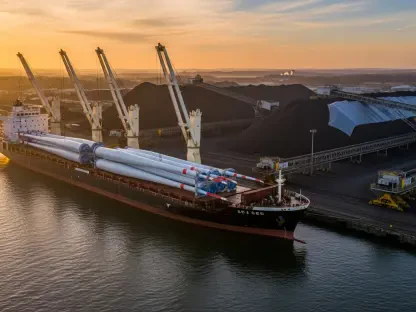Understanding Energy Efficiency and Its Global Relevance
In a world grappling with the dual challenge of soaring energy demand and the urgent need to slash carbon emissions, consider this striking reality: over two-thirds of primary energy is wasted before it even reaches its intended use, underscoring the critical importance of energy efficiency. Defined as achieving the same outcomes—be it heating a home, powering a factory, or driving a vehicle—with significantly less energy input, energy efficiency stands as a cornerstone of the transition to a lower-carbon economy, offering a pathway to mitigate climate change while addressing escalating global energy needs.
Current global energy systems are riddled with inefficiencies, losing substantial amounts of energy through production, transmission, and distribution processes. With energy demand projected to rise steadily, driven by population growth and industrialization, the imperative for decarbonization has never been more pressing. The reliance on fossil fuels continues to dominate, amplifying the carbon footprint, while inefficient technologies and practices exacerbate the strain on limited resources, highlighting the need for systemic change.
The scope of energy efficiency spans critical sectors such as buildings, transport, and industry, positioning it as a cost-effective strategy to meet net-zero emissions goals. Recognized by influential bodies like the International Energy Agency (IEA), which dubs it the “first fuel,” energy efficiency is prioritized for its potential to reduce demand before new supply is needed. Global commitments, such as those made at COP 28, where over 120 countries pledged to double efficiency improvements by 2030, further cement its role as a linchpin in sustainable energy transitions.
The Impact of Energy Efficiency on Decarbonization
Major Trends Driving Energy Efficiency
A powerful shift toward net-zero targets is propelling energy efficiency into the spotlight, with governments and corporations alike prioritizing sustainable practices. This momentum is fueled by rapid adoption of cutting-edge technologies, such as LED lighting and electric vehicles, which drastically cut energy waste compared to traditional alternatives. These innovations are not just technical upgrades but symbols of a broader movement toward smarter resource use.
Consumer behavior is also evolving, with growing demand for sustainable products pushing industries to innovate. Rising energy costs act as a market driver, compelling businesses and households to embrace efficiency measures as a means of cost control. This shift is evident in choices ranging from energy-efficient appliances to optimized industrial processes, reflecting a societal push for greener living.
Emerging opportunities are reshaping the landscape, with AI-based energy management systems and smart thermostats offering precise control over consumption. Additionally, innovative business models like energy-as-a-service are gaining traction, providing subscription-style solutions for commercial users. These trends signal a dynamic future where technology and market mechanisms align to drive efficiency gains.
Quantifying the Potential: Data and Forecasts
The transformative potential of energy efficiency is backed by compelling data, with the IEA estimating that it could account for over a third of the CO2 reductions required by 2030 under a net-zero scenario. This significant contribution highlights its role as a rapid and effective decarbonization tool. As global electricity demand is expected to grow by 4% annually through 2050, efficiency measures become indispensable in curbing unchecked consumption.
Projections suggest that with robust efficiency systems, the growth in “useful” energy demand could be limited to 32% by 2050, a stark contrast to a potential 75% surge under current trends. This gap illustrates the profound impact of strategic interventions in energy use. Such forecasts emphasize the need for accelerated adoption across all sectors to align with sustainability goals.
Looking ahead, energy intensity improvements—currently advancing at a modest 1% per year—must ramp up to a 4% annual rate to meet global targets. This discrepancy between current progress and required action underscores the urgency of scaling up investments and policies. Forward-thinking strategies are essential to bridge this gap and ensure a sustainable energy trajectory.
Barriers to Adopting Energy Efficiency
Despite its clear benefits, the widespread adoption of energy efficiency faces significant hurdles, starting with behavioral inertia. Many individuals and organizations cling to familiar, inefficient practices due to habit or lack of awareness, slowing the transition to better alternatives. Overcoming this resistance requires targeted efforts to shift mindsets and habits.
Information gaps further complicate adoption, as potential benefits and payback periods of efficiency upgrades often remain unclear to decision-makers. Additionally, split incentives create friction, where the party investing in improvements does not directly reap the rewards, such as in rental properties. The rebound effect also poses a challenge, as energy savings sometimes lead to increased usage, offsetting gains.
Addressing these barriers demands innovative solutions, including comprehensive education campaigns to highlight long-term advantages over short-term costs. Financial incentives and creative financing models, such as performance-based contracts, can align interests and reduce upfront burdens. By tackling these obstacles head-on, stakeholders can unlock the full potential of energy efficiency as a decarbonization strategy.
Policy and Regulatory Frameworks Shaping Energy Efficiency
The regulatory landscape plays a pivotal role in advancing energy efficiency, with policies like the EU Ecodesign Directive setting stringent standards for product performance. Similarly, programs such as the US Energy Star label guide consumers toward high-efficiency options, fostering market transformation. These frameworks establish benchmarks that drive innovation and compliance across industries.
Financial incentives are equally crucial, with mechanisms like tax credits and retrofit grants easing the initial costs of adopting efficient technologies. Such support is vital for encouraging businesses and homeowners to invest in upgrades, from insulation to advanced HVAC systems. Governments worldwide are leveraging these tools to stimulate action and scale impact.
Global commitments, exemplified by the COP 28 pledge to double efficiency improvements by 2030, signal a unified push for progress. However, the effectiveness of these pledges hinges on robust compliance and enforcement mechanisms to ensure accountability. Strengthened policy frameworks, coupled with international cooperation, are essential to translate ambition into measurable outcomes.
Future Outlook: Energy Efficiency as a Catalyst for Change
Looking toward the horizon, energy efficiency stands poised to benefit from groundbreaking technologies like advanced building materials that minimize energy loss. AI-driven energy systems are also set to revolutionize consumption patterns by optimizing usage in real time. These advancements promise to elevate efficiency to new heights, reshaping how energy is managed across sectors.
Market disruptors, including novel financing models like green bonds, are creating fresh avenues for investment in efficiency projects. The growing influence of investor stewardship is another game-changer, as financial stakeholders increasingly demand corporate accountability on energy metrics. These dynamics are fostering an environment where efficiency is not just a choice but a business imperative.
Consumer preferences for sustainability, alongside global economic conditions, are likely to further shape demand for efficient solutions. Emerging markets, projected to drive 85% of global electricity demand growth by 2050, represent both a challenge and an opportunity. Focused investments in these regions could yield outsized environmental and economic returns, positioning efficiency as a cornerstone of global energy transitions.
Harnessing Energy Efficiency for a Sustainable Tomorrow
Reflecting on the insights gathered, energy efficiency emerges as an indispensable tool in the quest to reduce emissions and manage escalating energy demands while delivering substantial cost savings. The exploration of its impact revealed a clear consensus on its potential to transform global energy systems, despite persistent barriers that slow adoption rates.
Actionable steps forward include a stronger emphasis on policy innovation, with governments encouraged to enhance regulatory frameworks and incentives. Businesses are urged to integrate efficiency into core strategies, leveraging technologies like AI for optimized operations. Investors, too, play a pivotal role by prioritizing engagements that push for measurable energy intensity reductions.
Looking beyond immediate challenges, the dialogue shifts to long-term collaboration across sectors and regions, particularly in emerging markets where impact could be profound. The journey underscores that while significant strides have been made, the path to a sustainable future demands sustained commitment and inventive approaches to financing and technology deployment, ensuring energy efficiency remains at the heart of decarbonization efforts.









